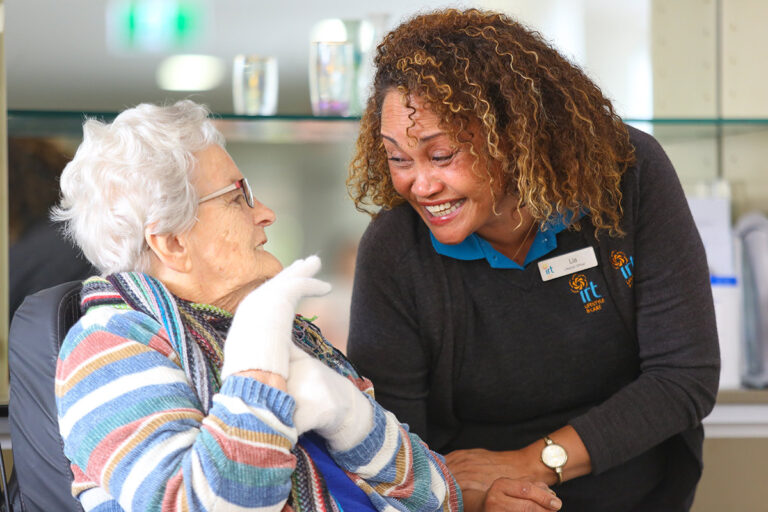50 purposeful activities for people living with dementia
For the estimated 447,000 Australians who live with dementia, it can be difficult to perform activities they may once have loved. Lack of stimulation and boredom can exacerbate the frustration of a person living with dementia, so it’s important to find activities that engage them and bring pleasure to their everyday lives.

As human beings, we engage in activities each and every day that provide us with purpose and pleasure. Things that stimulate our minds, and bring us enjoyment. These activities are different for each of us – baking, reading, knitting, climbing mountains, jumping out of aeroplanes…
But for the estimated 447,000 Australians who live with dementia, it can be difficult to perform activities they may once have loved, even though the need to do so has not been diminished. Lack of stimulation and boredom can exacerbate the frustration of a person living with dementia, so it’s important to find activities that engage them and bring pleasure to their everyday lives.
This will be different for each person, as we all have a unique set of likes and dislikes based on our history, lived experiences, emotions and personalities - it is not a ‘one size fits all’ scenario.
Planning Activities: 10 Essential Tips
1. Understand the person:
Discover their cultural background, work history, hobbies, and treasured memories.
2. Tailor activities
For example, a former farmer may enjoy seed-sorting or planting.
3. Avoid over-stimulation
Too much noise or crowding can lead to distress.
4. Leverage daily life tasks
Simple chores like setting the table can be engaging when done together.
5. Tap into memories
Music, dance, and looking through old photos can spark joy and recollection.
6. Keep things simple
One step at a time; avoid overwhelming them.
7. Prepare a calm workspace
A clutter-free, safe, and comfortable area is essential.
8. Stay flexible
If today doesn’t go well, try again another time.
9. Match timing to energy levels
Morning people might flourish early, while others may respond better in afternoons or evenings.
10. Record and repeat
Note what works—especially useful for shared caregiving.
Each activity is matched with its purposeful benefit, and categorised by stage suitability:
Day-to-Day Tasks (Support motor skills and routine)
- Folding towels (motor coordination)
- Pairing socks (attention, sorting)
- Setting the table (routine, independence)
- Brushing teeth (daily health habit)
- Making the bed (sense of accomplishment)
- Sweeping (movement and purpose)
- Meal prep (independence, sensory input)
- Washing dishes (routine and satisfaction)
Outdoor Engagement (Sensory, physical activity)
- Walking (fresh air, mobility)
- Planting flowers/veggies (nurturing, sensory)
- Watering plants (routine, responsibility)
- Raking leaves (motor activity)
- Park visits (nature, calm)
- Bench sitting/watching the world (relaxation)
- Ball toss/kick (gentle exercise)
- Beach trips (sound, touch, environment)
- National park outings (connectedness)
- Picnics (social/food enjoyment)
- Fishing (yields calm focus)
- Swimming/aqua aerobics (movement, fun)
- Feeding ducks (simple pleasure)
Learn how to make your home dementia friendly

Creative & Cognitive Expression
- Listening to music (memory recall, mood enhancement)
- Painting or drawing (creativity, expression)
- Scrapbooking old photos (memory, storytelling)
- Vision board creation (identity, expression)
- Chair yoga (gentle stretch)
- Word puzzles (mental stimulation)
- Crossword or word searches (cognitive challenge)
- Memory matching cards (mental engagement)
- Guess the sound games (sensory awareness)
Indoor Hobbies & Social Interaction
- Knitting or crocheting (fine motor, creativity)
- Colouring books (relaxation, focus)
- Seating dance routines (fun and movement)
- Playing board or card games (cognitive/social interaction)
- Watching sports on TV (familiarity, conversation)
- Reading magazines/newspapers (connection to the world)
- Jigsaw puzzles (focus and satisfaction)
- Cooking or baking (sensory, routine, social)
- Play-doh modelling (creativity, tactile)
Sensory & Tactile Engagement
- Peg sorting by colour (attention and motor)
- Sewing buttons on ribbon (fine motor control)
- Fingerpainting (creative, sensory)
- Handling nuts & bolts (motor, familiar tools)
- Padlock opening (problem-solving)
- Tossing sensory beanbags (coordination, textures)
- Bead necklace crafting (fine motor, sequencing)
- Smelling flowers or essential oils (calming)
- Stroking pet or textured fabrics (comfort)
- Memory rummage box (nostalgia)
- Hand massage or grooming activity (comfort, personal care)
Understand the early signs of dementia

Aged care services with IRT
IRT are the leaders in person-centred dementia care. Our innovative Journey of Care model enables us to tailor our dementia care environments, equipment and programs to meet the unique needs of residents living with dementia.
Find out moreSubscribe to our newsletter
You may also like
Maintaining balance and coordination with age and the positive impact of exercise
We are all living longer, so being in good physical and mental shape is key to making the most of those extra years. The Good…
Art as therapy in aged care: what you need to know
Here we explore the role of art as therapy in residential aged care, particularly for those living with dementia.


